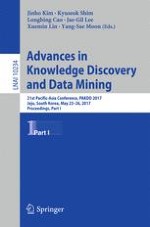This two-volume set, LNAI 10234 and 10235, constitutes the thoroughly refereed proceedings of the 21st Pacific-Asia Conference on Advances in Knowledge Discovery and Data Mining, PAKDD 2017, held in Jeju, South Korea, in May 2017.
The 129 full papers were carefully reviewed and selected from 458 submissions. They are organized in topical sections named: classification and deep learning; social network and graph mining; privacy-preserving mining and security/risk applications; spatio-temporal and sequential data mining; clustering and anomaly detection; recommender system; feature selection; text and opinion mining; clustering and matrix factorization; dynamic, stream data mining; novel models and algorithms; behavioral data mining; graph clustering and community detection; dimensionality reduction.
